Sainte-Chapelle A Gothic Jewel in the Heart of Paris
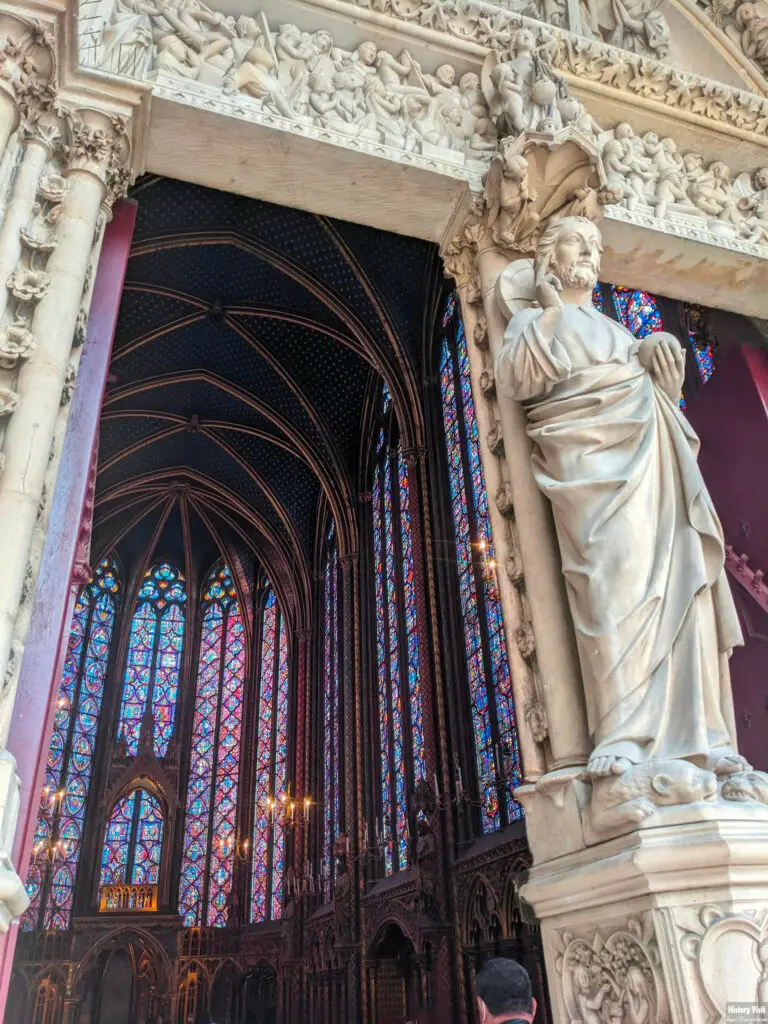
Introduction
Sainte-Chapelle, an architectural marvel situated in the heart of Paris, stands as one of the most exquisite embodiments of Gothic artistry. Built in the mid-13th century under the commission of King Louis IX, this royal chapel was designed to house sacred Christian relics, including the revered Crown of Thorns. Sainte-Chapelle’s design, marked by its verticality, intricate detail, and ethereal light, not only reflects the grandeur of Gothic architecture but also symbolizes the profound spiritual and political aspirations of medieval France. Its towering stained glass windows and intricate sculptures narrate biblical stories and embody the divine right of the monarchy, making it a site of immense historical and religious significance.
The chapel’s stunning architecture, characterized by pointed arches, ribbed vaults, and flying buttresses, showcases the innovative engineering techniques of the Gothic era. The extensive use of stained glass transforms the interior into a celestial space, while the meticulously carved sculptures add to its rich iconographic program. Despite facing periods of neglect and damage, particularly during the French Revolution, Sainte-Chapelle has been meticulously restored and preserved, allowing it to remain a cherished monument of Gothic art and history. Today, it continues to captivate visitors from around the world, standing as a testament to the enduring power of faith, art, and the visionary spirit of medieval architecture.
Origins and Historical Significance

Sainte-Chapelle was commissioned by King Louis IX, later canonized as Saint Louis, in the early 13th century. Its primary purpose was to house his collection of Passion relics, most notably the Crown of Thorns, which he acquired from Emperor Baldwin II of Constantinople. These relics were not only sacred objects of immense spiritual value but also potent symbols of the divine authority and legitimacy of Louis’s rule. The construction of such a grand chapel to enshrine these relics underscored the king’s piety and his kingdom’s central role in Christendom, reinforcing the notion of France as the “Eldest Daughter of the Church.”
Completed in 1248, Sainte-Chapelle was integrated into the royal palace complex on the Île de la Cité, the heart of medieval Paris and the center of the French monarchy’s power. Its location within the palace precincts symbolized the intimate relationship between the monarchy and the church. The chapel’s design and function mirrored the dual nature of the king’s authority, both temporal and spiritual, providing a sacred space where the king could worship and showcase his devotion to God.
The relics enshrined within Sainte-Chapelle elevated its status to that of a pilgrimage site, attracting worshippers from across Europe. These relics were believed to have miraculous powers, further enhancing the chapel’s religious significance. The presence of such holy artifacts within the royal chapel not only reinforced the sanctity of the French monarchy but also linked it directly to the Passion of Christ, thereby asserting the king’s divine right to rule.
Over the centuries, Sainte-Chapelle has witnessed numerous historical events, from royal ceremonies to periods of strife. During the French Revolution, the chapel suffered significant damage as revolutionary forces sought to dismantle symbols of the old regime. Many of the relics were dispersed or destroyed, and the chapel itself was repurposed for various secular uses. Despite these challenges, Sainte-Chapelle’s historical and cultural importance ensured that efforts to restore and preserve it began in earnest in the 19th century, allowing it to remain a cherished monument of Gothic art and history.
Architectural Brilliance

Sainte-Chapelle stands as a masterpiece of Gothic architecture, showcasing the innovative design and engineering techniques of the 13th century. Architect Pierre de Montreuil, credited with its creation, designed the chapel to embody the key elements of Gothic style, including verticality, light, and intricate detail. The chapel’s dual-level structure is a striking feature, with the lower chapel intended for palace staff and the upper chapel reserved for the king and his close entourage. This hierarchical design reflects the social stratification of the medieval period and underscores the chapel’s role as a royal sanctuary.
The upper chapel is renowned for its stunning stained glass windows, which dominate the space and create a celestial atmosphere. These windows, comprising 15 towering panels, depict over 1,100 scenes from the Bible, from Genesis to the Passion of Christ. The vibrant colors and intricate details of the glasswork are a testament to the craftsmanship of the medieval artisans. As sunlight streams through the stained glass, it bathes the chapel in a kaleidoscope of colors, symbolizing the divine light and the presence of God.

One of the most remarkable aspects of Sainte-Chapelle’s architecture is its use of skeletal framework, a hallmark of Gothic design. The extensive use of pointed arches and ribbed vaults allowed for the construction of high walls and large windows, minimizing the need for solid walls and creating a sense of openness and lightness. This architectural innovation not only enhanced the aesthetic appeal of the chapel but also served a functional purpose by distributing weight more efficiently, ensuring the structural integrity of the building.
The exterior of Sainte-Chapelle is equally impressive, with its elaborate façade featuring detailed stone carvings and statues. The spire, soaring over 75 meters above the ground, is a prominent feature of the Parisian skyline and a symbol of the chapel’s heavenly aspirations. The attention to detail in both the exterior and interior design of Sainte-Chapelle exemplifies the Gothic commitment to creating a space that inspires awe and reverence, drawing the faithful closer to the divine.
Gothic Features
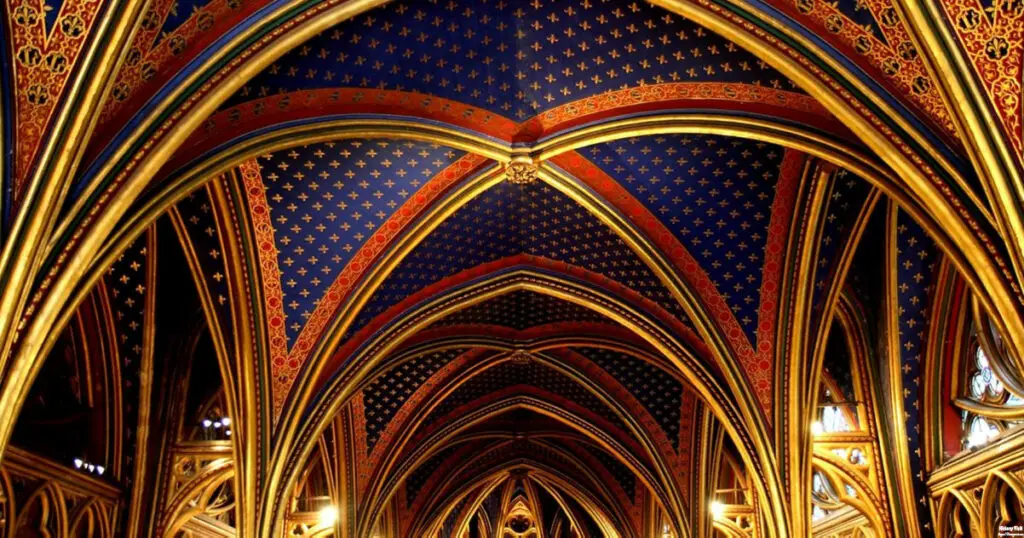
Sainte-Chapelle is a quintessential example of Gothic architecture, characterized by its emphasis on height, light, and intricate detail. One of the most defining features of Gothic architecture present in Sainte-Chapelle is the pointed arch. These arches, found throughout the chapel, provide both aesthetic grace and structural stability. By directing the weight of the roof downwards and outwards, pointed arches allow for taller and more slender walls, contributing to the chapel’s soaring verticality.
Ribbed vaults are another key element of Gothic architecture that can be seen in Sainte-Chapelle. These vaults consist of intersecting ribbed arches that create a framework for the ceiling. This design not only adds to the chapel’s visual complexity but also distributes the weight of the roof more evenly, allowing for the inclusion of large windows. The ribbed vaults in Sainte-Chapelle are not merely functional; they are also highly decorative, with intricate patterns that enhance the overall aesthetic of the interior.

Flying buttresses, though less prominent in Sainte-Chapelle compared to other Gothic cathedrals, play a crucial role in supporting the chapel’s high walls and extensive glasswork. These external supports transfer the weight of the roof and upper walls away from the structure, enabling the construction of expansive windows that are a hallmark of Gothic design. The use of flying buttresses in Sainte-Chapelle demonstrates the innovative engineering solutions developed during the Gothic period to achieve greater heights and more light-filled interiors.
Ornate tracery is another characteristic feature of Gothic architecture that is beautifully exemplified in Sainte-Chapelle. The intricate stonework that frames the stained glass windows is not only decorative but also structural, providing support to the delicate glass panels. The tracery in Sainte-Chapelle is highly detailed, with complex patterns that add to the visual richness of the chapel. This combination of functionality and ornamentation is a key aspect of Gothic design, reflecting the era’s commitment to creating spaces that are both beautiful and structurally sound.
Sculptures

The sculptures of Sainte-Chapelle are integral to its Gothic splendor, contributing both to its decorative richness and its spiritual narrative. The exterior of the chapel is adorned with numerous statues of saints and biblical figures, each meticulously carved to convey emotion and story. These sculptures greet visitors as they approach, setting a reverent tone even before they enter the sacred space. The figures are arranged in niches and along the façade, their detailed expressions and poses reflecting the Gothic love for naturalism and storytelling.
Inside the chapel, the sculptural work continues to captivate. The lower chapel features a series of column statues and capitals decorated with foliage and human figures, blending the natural with the spiritual. These sculptures not only serve a decorative purpose but also provide a narrative function, illustrating scenes from the Bible and the lives of saints. The intricate carvings on the columns and capitals showcase the skill of the medieval artisans and their ability to integrate complex iconography into the architectural framework.

The upper chapel, reserved for the king and his close entourage, includes some of the most impressive sculptures in Sainte-Chapelle. The statues of the Twelve Apostles stand majestically against the backdrop of the stained glass windows, each figure rendered with a serene expression and flowing garments. These statues serve as silent guardians of the relics housed within the chapel, their presence adding to the sacred atmosphere. The apostles’ statues are arranged around the nave, creating a sense of unity and continuity within the space.
The portal of Sainte-Chapelle is another masterpiece of Gothic sculpture, featuring intricate reliefs depicting scenes from the Last Judgment. This common theme in Gothic portals serves to remind worshippers of the final reckoning and the importance of living a righteous life. The detailed carvings of angels, saints, and the damned are rendered with expressive detail, illustrating the dramatic narrative of judgment and redemption. The portal’s sculptures not only enhance the chapel’s aesthetic appeal but also convey a powerful theological message, reinforcing the spiritual purpose of the space.
Cultural and Religious Impact
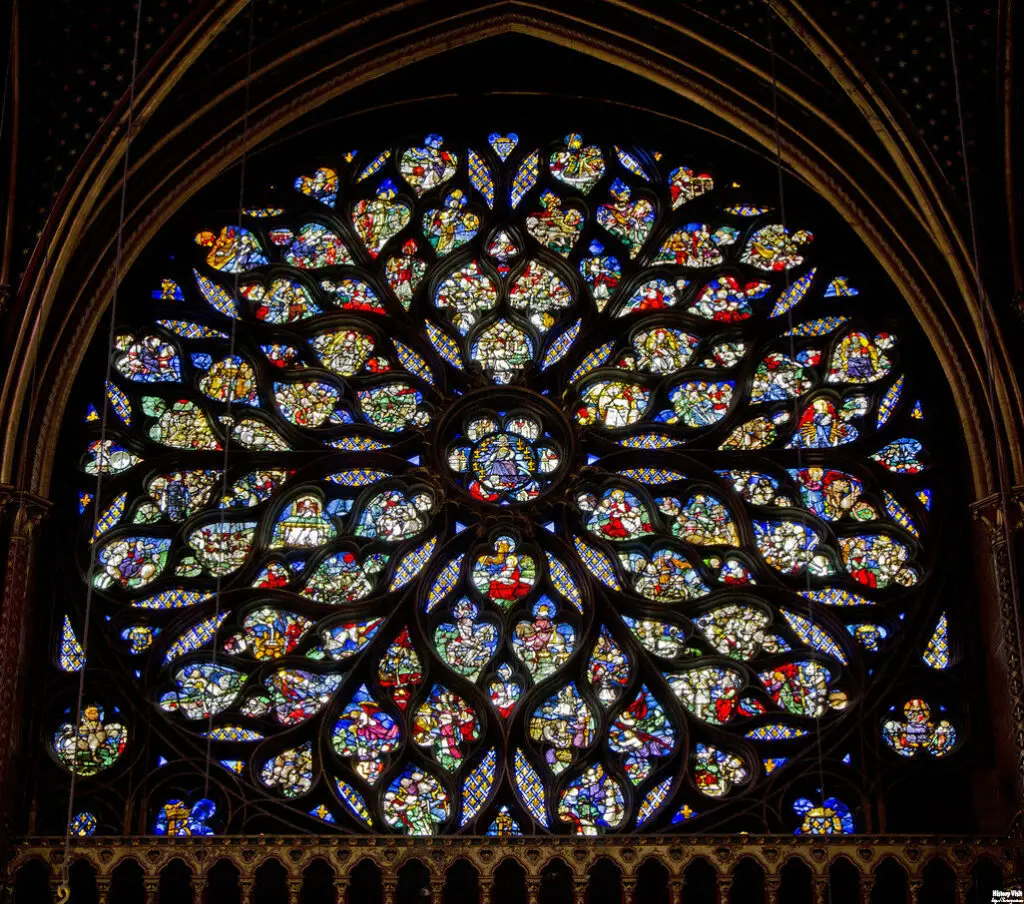
Beyond its architectural splendor, Sainte-Chapelle served as a powerful symbol of the divine right of kings and the sanctity of the French monarchy. The chapel was not merely a place of worship but a statement of the king’s piety and the kingdom’s central role in Christendom. By housing the Passion relics, Sainte-Chapelle became a site of immense religious significance, attracting pilgrims and enhancing the spiritual prestige of the French monarchy. The presence of such relics linked the monarchy directly to the Passion of Christ, reinforcing the notion of the king’s divine right to rule.
The dedication of Sainte-Chapelle to housing these relics also had a profound impact on its cultural significance. The chapel became a symbol of the French monarchy’s spiritual authority and its role as a protector of the Christian faith. The relics, believed to have miraculous powers, drew pilgrims from across Europe, further enhancing the chapel’s religious and cultural importance. The chapel’s role as a pilgrimage site also contributed to the spread of Gothic architecture and art, as visitors carried back ideas and inspiration to their own regions.
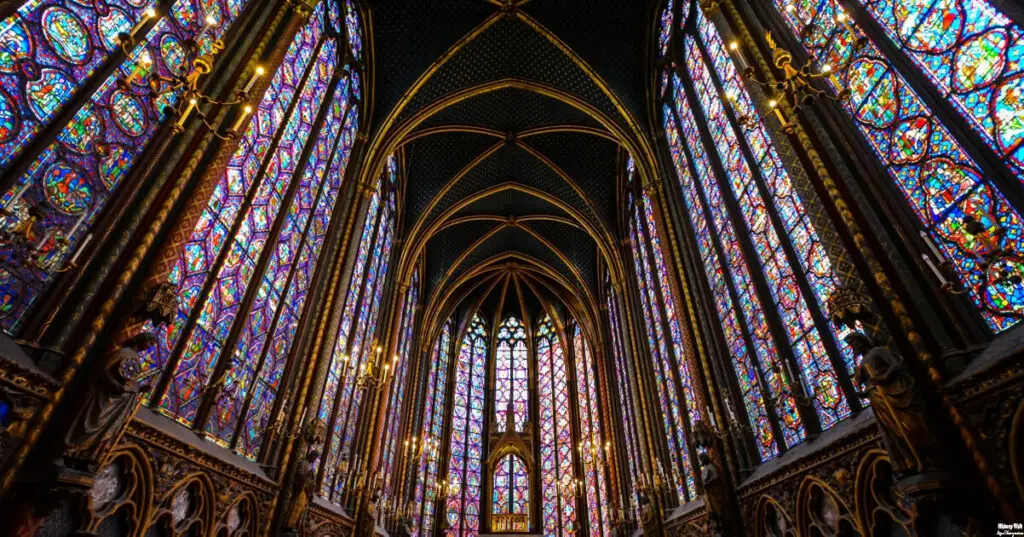
Throughout the centuries, Sainte-Chapelle has witnessed numerous historical events, from royal ceremonies to periods of strife. During the French Revolution, the chapel suffered significant damage as revolutionary forces sought to dismantle symbols of the old regime. Many of the relics were dispersed or destroyed, and the chapel itself was repurposed for various secular uses. Despite these challenges, the historical and cultural importance of Sainte-Chapelle ensured that efforts to restore and preserve it began in earnest in the 19th century, allowing it to remain a cherished monument of Gothic art and history.
Today, Sainte-Chapelle continues to be a major attraction for visitors from around the world, drawing them to its stunning architecture and rich history. The chapel’s role as a symbol of the French monarchy’s spiritual and cultural legacy endures, making
it a powerful reminder of the medieval period’s artistic and religious achievements. Its breathtaking stained glass, intricate sculptures, and innovative architectural features continue to inspire awe and reverence, solidifying Sainte-Chapelle’s status as a pinnacle of Gothic grandeur and a testament to the enduring power of faith and art.
Preservation and Legacy
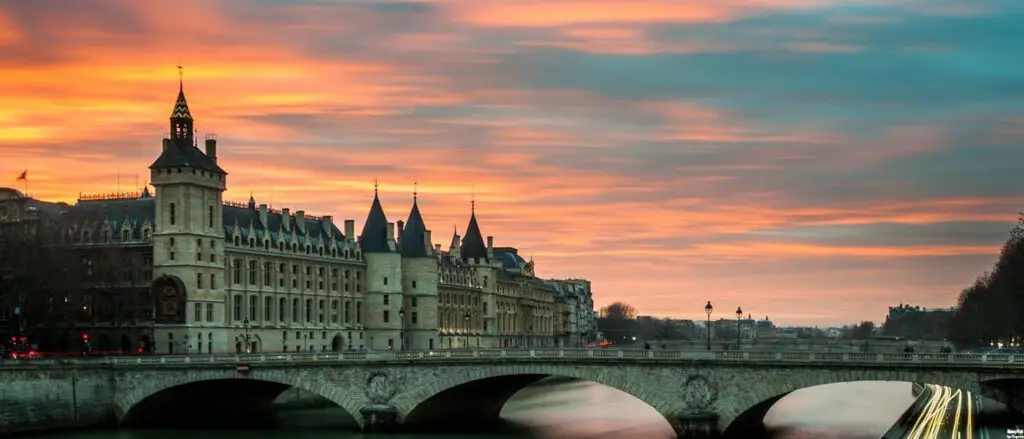
Throughout the centuries, Sainte-Chapelle has faced numerous challenges, including damage during the French Revolution and various periods of neglect. During the revolution, the chapel’s stained glass windows were removed or hidden to protect them from destruction, and many of the sculptures and other decorative elements were damaged or defaced. The chapel was repurposed for secular uses, including as a storage facility and an administrative office, further contributing to its deterioration. Despite these hardships, the intrinsic value and historical significance of Sainte-Chapelle ensured that efforts to restore and preserve it would eventually begin.
In the 19th century, extensive restoration efforts were undertaken, particularly under the direction of architect Eugène Viollet-le-Duc, who played a crucial role in preserving many of France’s Gothic monuments. Viollet-le-Duc’s work on Sainte-Chapelle involved meticulous research and careful restoration of the chapel’s stained glass windows, sculptures, and architectural elements. His efforts helped to return the chapel to its former glory, ensuring that future generations could appreciate its beauty and historical importance.
Today, Sainte-Chapelle is recognized as a UNESCO World Heritage Site, a testament to its significance as a cultural and historical landmark. The chapel continues to attract visitors from around the world, who come to marvel at its stunning architecture and vibrant stained glass. Modern preservation efforts focus on maintaining the structural integrity of the chapel, protecting its delicate glasswork, and ensuring that its intricate sculptures remain in good condition. These efforts are essential to safeguarding Sainte-Chapelle’s legacy and allowing it to continue inspiring awe and reverence.
In conclusion, Sainte-Chapelle is more than just a chapel; it is a Gothic masterpiece that embodies the spiritual and artistic heights of the medieval period. Its breathtaking stained glass, architectural innovation, and historical significance continue to inspire awe and reverence, making it an enduring symbol of Gothic grandeur in the heart of Paris. The addition of its exquisite sculptures further enhances its status as a pinnacle of Gothic artistry and religious devotion. Through ongoing preservation efforts, Sainte-Chapelle remains a cherished monument, offering a glimpse into the medieval past and the enduring power of faith and art.
Conclusion
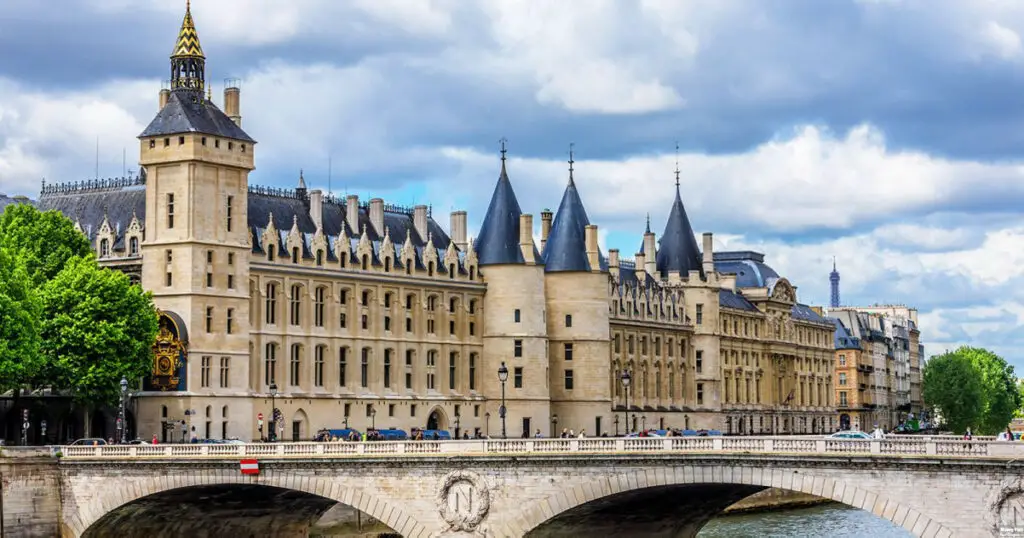
Sainte-Chapelle remains a shining example of the ingenuity and spiritual fervor that defined the Gothic era. Its breathtaking stained glass, intricate sculptures, and innovative architectural features continue to captivate and inspire all who visit. This magnificent chapel not only serves as a monument to medieval artistry but also as a testament to the profound religious and cultural legacy of the French monarchy. By preserving its historical and artistic integrity, Sainte-Chapelle allows us to glimpse the heights of Gothic ambition and the deep intertwining of faith and power that shaped its creation.
The enduring allure of Sainte-Chapelle lies in its ability to transcend time, offering a window into the medieval past while continuing to resonate with contemporary audiences. As a UNESCO World Heritage Site, it stands as a reminder of the importance of preserving our cultural heritage. Through ongoing restoration efforts, Sainte-Chapelle remains a beacon of Gothic grandeur, a symbol of divine light, and a testament to the enduring power of architectural and artistic expression. Its legacy, preserved for future generations, ensures that the awe and reverence it inspires will never fade, solidifying its place as one of the most cherished monuments in the world.


